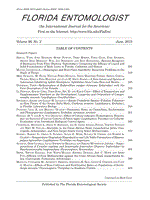Rhodomyrtus tomentosa (Alton) Hassk. (Myrtales: Myrtaceae) is a long lived evergreen shrub with large pink flowers and edible fruit. The native distribution of R. tomentosa includes much of southern Asia and the Philippines (Langeland & Craddock Burks 1998). Beginning in the late 1800s R. tomentosa was exported to various locations worldwide, including the states of Hawaii and Florida in the USA. The exotic shrub has escaped cultivation in both locations and invaded natural areas where it displaces native vegetation (Langeland & Craddock Burks 1998). The development of a biological control program targeting R. tomentosa has resulted in several surveys for host specific natural enemies in the plant's native range (Krauss 1966; Winotai et al. 2005). Recently, 2 lepidopteran species were discovered feeding on R. tomentosa during surveys in China.
On 30 Mar 2012, 43 larvae of a lasiocampid species were observed resting as a communal group on R. tomentosa branches near Kau Tarn Tso (N 22° 30.248′ E 114° 15.045′) in the Wu Kau Tang area of Hong Kong, China. Larvae regurgitated a droplet of partially digested fluid when collected or when disturbed. While branches near the resting group were defoliated, larvae were held in a plastic container (10 × 10 × 5 cm) with R. tomentosa leaves to confirm that they consumed the target plant. Following positive results, larvae were shipped on 2 Apr 2012 to the quarantine facility at the United States Department of Agriculture (USDA), Agriculture Research Service (ARS), Invasive Plant Research Lab (IPRL) in Fort Lauderdale, Florida USA under permit # P-09-02955. Upon arrival, larvae were placed within a ventilated clear plastic container (50 × 50 × 50 cm) provisioned exclusively with R. tomentosa foliage until pupation. General maintenance of the colony resulted in several instances of larval setae imbedding in human skin, although no prolonged irritation occurred. Larvae rested communally during the day and fed at night. The resulting adults mated within the cage and oviposition ensued 4 days later; dead adults were preserved for identification. Eggs were placed in several petri dishes and held at 25 °C until hatching. To confirm that R. tomentosa supports complete development of the species, neonates were transferred to 1 of 3 ventilated plastic containers and fed leaves of the target plant until pupation. Adults were identified as Metanastria gemella Lajonquiere (Lasiocampidae), a species whose geographic range includes Sundaland, Palawan, and southern China (Holloway 1987). The host range of M. gemella is poorly understood but Holloway (1987) postulates that this species has a similar diet breadth as its congener Metanastria hyrtaca Cramer, which is a broad generalist. To our knowledge, the only host of M. gemella reported in the literature is the plantation tree Neolamarckia cadamba (Roxb.) Bosser (Gentianales: Rubiaceae) in Sandakan, Malaysia (Chung et al. 2009). These data clearly demonstrate that R. tomentosa is a developmental host of M. gemella and lends evidence that the species is a generalist, feeding on species across at least 2 plant families. It should also be noted that 4 tachinid flies emerged from M. gemella pupae and were identified as Blepharipa sp. by Norman E. Woodley of the Systematic Entomology Laboratory (SEL), ARS, USDA, Smithsonian Institution, Washington, DC, USA. Voucher specimens are lodged at the SEL.
On 4 Jun 2012 ca. 100 small orange lymantriid larvae were observed feeding on R. tomoentosa near Shitan, Guangxi Province, China (N 21° 48.273′E 108° 58.106′). Larvae were shipped under the permit listed above to the IPRL quarantine facility on 18 Jun 2012. Larvae were fed R. tomentosa leaves in a cage similar to that described above and remained gregarious throughout their development. When disturbed, larvae wagged their heads and thoraces from side to side in an apparently defensive behavior. Pupation occurred within light yellow silken cocoons and the resulting adults were mated; dead adults were preserved for identification. No parasitoids were recovered from the colony. Eggs arising from the adults were light yellow and covered in the yellow scales of the female. Neonates were transferred to several plastic cages and fed exclusively R. tomentosa until pupation, demonstrating that the target weed is a developmental host. Adults of the lymantriid larvae were identified as Arna bipunctapex Hampson, a species that occurs across Southeast Asia, from India to Taiwan and Sundaland. Hosts of this species include representatives from 12 families, although R. tomentosa is not among the recorded food plants (Holloway 1987; Robinson et al. 2012). Voucher specimens are lodged at the SEL.
SUMMARY
Surveys for host specific natural enemies of Rhodomyrtus tomentosa (Myrtales: Myrtaceae), rose myrtle, in China (mainland and Hong Kong) resulted in the discovery of 2 lepidopteran species that have not been previously reported as herbivores of the plant: Metanastria gemella Lajonquiere (Lasiocampidae) and Arna bipunctapex Hampson (Lymantriidae). Multiple generations of both species were reared on R. tomentosa in a quarantine laboratory, demonstrating that the plant is a developmental host. However, neither species demonstrates sufficient host specificity to be considered for biological control of R. tomentosa in the USA.
Key Words: biological control, herbivores, host specificity, invasive species, rose myrtle
RESUMEN
Un sondeo de los enemigos naturales específicos de Rhodomyrtus tomentosa (Myrtales: Myrtaceae), rosa mirto, en China (continental y Hong Kong) resultó en el descubrimiento de dos especies de lepidópteros que no han sido previamente reportados como herbívoros de la planta: Metanastria gemella Lajonquiere (Lasiocampidae) y Arna bipunctapex Hampson (Lymantriidae). Varias generaciones de ambas especies fueron criadas sobre R. tomentosa en un laboratorio de cuarentena, lo que demuestra que la planta es un hospedero en que estas especies pueden desarrollarse. Sin embargo, las dos especies no demostraron una suficiente especificidad sobre el hospedero para ser considerados en el control biológico de R. tomentosa en los EE.UU.
Palabras Clave: control biológico, herbívoros, especificidad del hospedador, especies invasoras, rosa mirto





